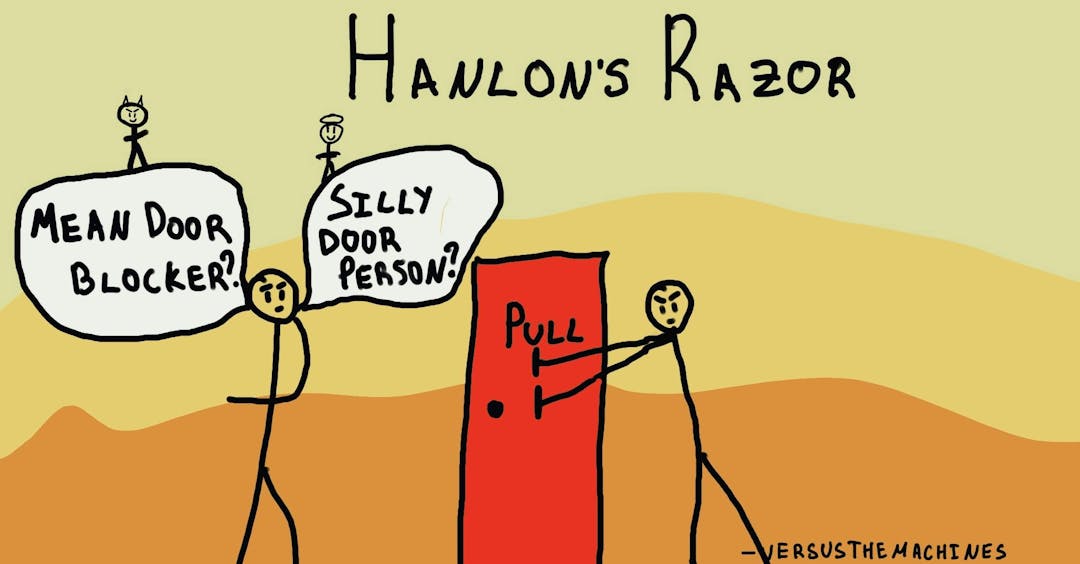Service Blueprints
The Basic Idea
Imagine you want to order a pizza for dinner, so you place an online order with your favorite spot. While you wait for the delivery, a staff member receives your order and springs into action, tossing fresh dough and preparing your pizza just the way you want. They hand off the box with your freshly baked pizza to a delivery driver who places it in an insulated bag and drives off in your direction. Other employees are busy wiping down kitchen surfaces, chopping vegetables, and mixing dough. Meanwhile, the manager sits in the back office ordering supplies and scheduling equipment maintenance.
These various elements work together like a well-oiled machine, ensuring your pizza arrives on time, steaming hot, and predictably delicious. The pizzeria operates at this level of efficiency and consistency because it operates following a service blueprint.
A service blueprint is a visualization of the various elements involved in delivering a service to a customer. It’s a map of the whole service process, including the people, actions, and objects that collaborate to support the customer journey and shape customer experiences at every touchpoint.2 These blueprints are widely used to design services and manage operations.
Mapping the service process makes it easier to understand how all the moving parts of a business come together to create customer experiences. This can help managers identify potential problems in their service processes, brainstorm ideas to improve efficiency, and understand how customers are impacted by what’s going on behind the scenes.
Consider this: a restaurant owner wants to expand their takeout and delivery business by adding in-house dining. What staff actions or backstage processes might need to change to accommodate this? Would the owner need to hire more workers or add another prep area to the kitchen? Without carefully considering the existing service process, adding dine-in services might create lengthy wait times and hurt the customer experience. A service blueprint can help the manager proactively address these challenges and incorporate changes as smoothly as possible.
A blueprint encourages creativity, preemptive problem solving, and controlled implementation. It can reduce the potential for failure and enhance management’s ability to think effectively about new services.
— G. Lynn Shostack, from Designing Services That Deliver2
Theory, meet practice
TDL is an applied research consultancy. In our work, we leverage the insights of diverse fields—from psychology and economics to machine learning and behavioral data science—to sculpt targeted solutions to nuanced problems.
Key Terms
Service Design: The process of organizing the various components of a business — including people, infrastructure, and processes — to improve the customer journey.3 The purpose of service design is to ensure every touchpoint of the customer journey leads to positive customer experiences. Service blueprinting is an important element of service design.
Customer Journey: The series of steps a customer takes after first learning about a company, encompassing every interaction with the brand that follows. Service blueprints include a map of the customer journey, linking each customer touchpoint with the internal business processes that support it.
Touchpoints: Any way customers interact with a business along the customer journey.4 These can include human-to-human or human-to-computer interactions. Some common touchpoints include social media posts, emails, phone calls, website visits, and checkouts.
Swimlanes: Horizontal sections in a service blueprint that categorize the various components of a service.5 These resemble lanes in a swimming pool, separating the activities of different actors and clarifying who is responsible for each step of the service process. Swimlanes also show whether an internal process is visible to the customer. Service blueprints typically have separate swimlanes for physical evidence, customer actions (touchpoints), frontstage processes, backstage processes, and support processes.
Physical Evidence: Objects or “props” that customers and staff members interact with, either tangible or digital.2 Examples can include appliances, signage, receipts, menus, websites, and inventory management platforms. Props play an important role in customer experience and can influence the efficiency and consistency of various service processes.
Frontstage Processes: Internal actions occurring in front of the customer, directly tied to customer touchpoints.2 In our pizza place example, frontstage actions might include greeting customers when they walk in, explaining menu options, taking orders, and addressing customer concerns.
Backstage Processes: Internal actions that occur behind the scenes — out of view of the customer — to support frontstage processes.2 In a pizzeria, these might include actions like preparing pizza dough, chopping vegetables, assembling pizzas, cleaning the kitchen, and relaying orders to kitchen staff.
Support Processes: Internal processes that support both frontstage interactions and backstage processes.2 Examples include inventory management, equipment maintenance, and staff training.
History
The process of service blueprinting was first described by banking executive G. Lynn Shostack in a Harvard Business Review article published in 1984.1 In the article, Shostack criticized the lack of systematic planning in service design. She disliked how most services were developed through a process of trial and error, and when things didn't work, managers often blamed employees for the failure.
Shostack also pointed out that existing methods for service management focused on internal organizational processes. These methods overlooked the human element, neglecting the impact that backstage processes have on customer experiences.
In an effort to make service design more systematic and customer-oriented, Shostack proposed a blueprint to map the entire process involved in delivering a service to a customer. Her original service blueprint included two swimlanes to categorize frontstage and backstage actions.
Since then, many scholars and marketing professionals have added to the service blueprinting technique. J. Kingman-Brundage was the first to suggest a more detailed framework in 1988, adding additional swimlanes to visualize the organizational structure of the business and define who is specifically involved in each action.6 She divided frontstage actions into two separate lanes: customer actions and service provider actions. Backstage actions were divided into service provider actions, support functions, and management functions.
Today, service blueprints can take many forms, but the general format tends to focus on core elements like customer actions, frontstage and backstage activities, and behind-the-scenes support processes.
People
G. Lynn Shostack: A founding figure in the world of service design, Shostack developed the concept of service blueprints as a method for mapping and understanding customer service experiences. She was a prominent businesswoman and marketing executive, holding roles at Citibank and other notable financial institutions.1
Consequences
Drawing up a service blueprint has several valuable applications for businesses, from helping stakeholders visualize the service process to pinpointing potential problems and opportunities for improvement.
Visualizing the Service Process
The primary value of service blueprinting is the ability to plan ahead, play around with different service designs, and see how various processes might fit together before implementing them. This reduces the need for costly trial and error.
Service blueprinting is particularly valuable in the modern business landscape where brands engage customers across multiple online channels and interact with customers at several different touchpoints.2 Without a blueprint, it can be difficult to understand how various departments (backstage and frontstage) depend on each other to deliver these customer experiences.
Service blueprints are also great for communicating complex service processes to stakeholders, giving them a better understanding of the process from a customer experience perspective. Because blueprints are precise, they reduce the likelihood of misinterpretation.1 At the same time, blueprints highlight the fact that process design is the responsibility of management — problems with the process are not the fault of employees, but a result of poor planning.
Diagnose Problems
Besides service planning, blueprints can highlight weak links in existing service processes. Many poor customer experiences are caused by system bottlenecks, but it’s not always easy to see where these bottlenecks are. For example, say that customers at our hypothetical pizza place have started complaining about long wait times. A service blueprint might reveal that the same staff member is involved in making pizzas and boxing them for takeout, creating delays during peak hours.
Similarly, blueprinting can identify possible failure points before they occur, allowing managers to establish processes to recover from errors as smoothly as possible.7 What if a staff member puts the wrong toppings on a pizza? What if the oven malfunctions during the dinner rush? What if a pizza is delivered to the wrong address? By incorporating potential failure points and recovery processes into the service blueprint, the pizzeria can develop a resilient service system that provides a positive customer experience, regardless of what hiccups occur along the way.
Discover Opportunities for Improvement
With a clear understanding of the entire service process, managers can also identify opportunities for improvement. For example, they might look for areas where automation could improve the customer experience, like adding real-time order tracking so customers can see their estimated delivery or pickup time, reducing customer inquiries and frustration.
Blueprints can also reveal redundancies, like the need to explain menu items or customization options to customers — perhaps this could be reduced by designing new menus with clear visuals and descriptions. Similarly, information collected from a customer, such as credit card numbers or order history, could be repurposed for later use to save time on frontstage and backstage processes.2
Controversies
While service blueprinting is incredibly valuable for service design, it’s not without its limitations and challenges.
Organizational Cooperation
Nielsen Norman Group surveyed 97 UX professionals about their experiences with service blueprinting and shared several of their greatest pain points.8 Many stated they had a hard time collaborating with organizations to get the support, commitment, and resources necessary for service blueprinting. Organizational politics were also common roadblocks in the blueprinting process as departments often disagreed on goals. UX professionals can work around these challenges by narrowing the initial scope of their blueprints to focus on specific goals, creating small wins that show the value of blueprinting.
Scope
Debates about scope are common when creating service blueprints. Intricate services with many steps can lead to cluttered blueprints, so service designers often have to decide which actions to include in a blueprint and which to leave out.8 Do you include every single customer touchpoint? Every backstage process? Include too much detail and stakeholders might not understand what they’re looking at, but include too little detail and the blueprint could overlook important challenges or opportunities. Experts recommend starting with around 8-12 customer actions and working out the internal processes from there.
Formatting
Similarly, the overall format of service blueprints has also been heavily debated. Which layers (or swimlanes) should be included in service blueprints? Should the blueprint include categories for the physical spaces where certain actions take place? What about customer emotional states? Many criticisms about service blueprinting are rooted in their lack of customer perspectives and their failure to capture the intricacies of customer behavior and emotion.6
Today, service design is heavily focused on customer experience, and many UX professionals have proposed changes to the service blueprint format to include more customer-oriented information. Some recent formats focus more heavily on the customer journey, breaking it down by phase and categorizing backstage processes as they relate to each stage of the customer journey.
Case Study
This 2022 study of a local restaurant in Taiwan is an excellent example of the use of service blueprinting to improve customer satisfaction.9 Researchers noted that the restaurant had been open since 2015 with no real progress, and suggested that a service blueprint could help identify potential problems. They interviewed the restaurant owners and observed the service process, then drew up a service blueprint.
Looking at the blueprint, the researchers were able to identify six failure points in the restaurant's service process. First, they noted the lack of order sheets, pointing out that servers had to memorize which tables ordered what, potentially leading to incorrect orders or people getting the wrong food.
The researchers also noticed failure points that occurred while customers were waiting for their food. Sometimes customers arriving first waited longer for their food than customers arriving after them — a sure way to make customers unhappy. Something was clearly going wrong in the process of order fulfillment. At the same time, people placing takeout orders had nowhere to wait, creating long lines and causing potential customers to walk out when it was busy.
Using these insights from the service blueprint, the researchers redesigned the service process. They introduced the use of order sheets and table numbers, adding new processes in which servers were to record orders in an order sheet and later check the order sheet before delivering orders to tables. They also suggested placing stools on the terrace — adding these stools as physical evidence in the service blueprint — where people could sit while they waited for takeout orders. They concluded that service blueprinting was valuable in highlighting potential service improvements that would boost customer satisfaction.
Related TDL Content
User Journey Map
A user journey map is a visualization of the steps a user takes when engaging with a product or service. Unlike service blueprints, user journey maps are focused entirely on the customer’s experience — no backstage processes or behind-the-scenes organizational actions. These maps include customer touchpoints as well as the mindsets and emotions of the customer, providing a comprehensive understanding of the entire customer experience.
7 Behavioral Tips for Designing the Ideal Customer Experience
Building a great customer experience is all about understanding the customer journey and designing customer touchpoints from a behavioral science perspective. This article explores how brands can craft user experiences that minimize cognitive load and offer proactive solutions to our imperfect — and often biased — memory and decision-making functions.
References
- Shostack, G. L. (1984). Designing Services That Deliver. Harvard Business Review. Retrieved April 9, 2024, from https://hbr.org/1984/01/designing-services-that-deliver
- Gibbons, S. (2017, August 27). Service Blueprints: Definition. Nielsen Norman Group. Retrieved April 9, 2024, from https://www.nngroup.com/articles/service-blueprints-definition/
- Myre, M. (2023). Service Design 101 | What is Service Design. Designlab. Retrieved April 9, 2024, from https://designlab.com/blog/what-is-service-design
- Customer touchpoints: How to identify them + examples. (n.d.). Delighted. Retrieved April 9, 2024, from https://delighted.com/blog/a-beginners-guide-to-customer-touchpoints
- What Are Service Blueprints? (n.d.). The Interaction Design Foundation. Retrieved April 9, 2024, from https://www.interaction-design.org/literature/topics/service-blueprint
- Haugen, M. (2013) Service blueprints: Persistent qualities and future potential. Norwegian University of Science and Technology. https://www.ntnu.no/documents/10401/1264433962/MargretheHArtikkel.pdf
- Martin, D. & Gibson, S. (2023) Solving the Drive-through Crisis with Service Blueprinting. CABI. doi: 10.1079/9781800621022.0020
- Joyce, A., & Gibbons, S. (2020, March 22). Service Blueprinting: Fails and Fixes. Nielsen Norman Group. Retrieved April 9, 2024, from https://www.nngroup.com/articles/blueprint-fails-fixes/
- Dewi, L. T., Nguyen Thi Chinh, & Keren Kerviona. (2022). Service Blueprinting to Enhance Restaurant’s Service Process. International Journal of Industrial Engineering and Engineering Management, 4(1), 1-6. https://doi.org/10.24002/ijieem.v4i1.5506
About the Author
The Decision Lab
The Decision Lab is a Canadian think-tank dedicated to democratizing behavioral science through research and analysis. We apply behavioral science to create social good in the public and private sectors.



